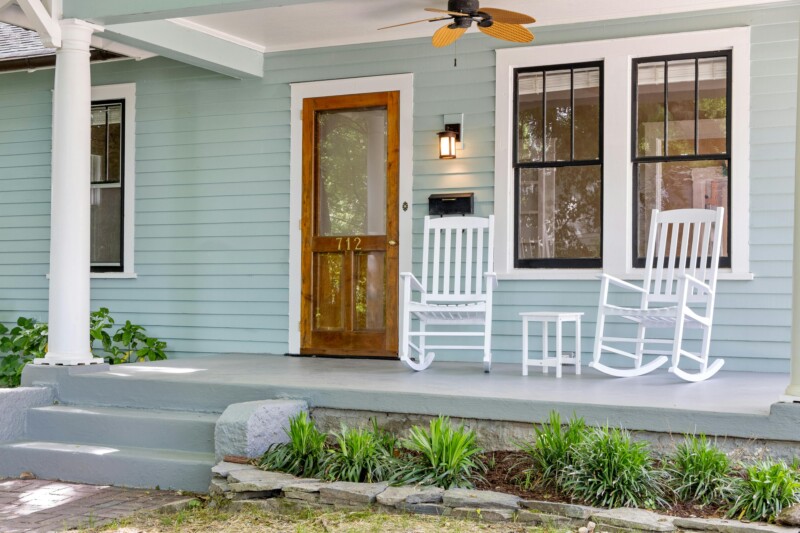Replacing Porch Columns: What to Know Before You Start
Porch columns often support structural loads, meaning replacing them isn’t simply a style decision. If you’re dealing with rot, sagging, an outdated design, or other concerns, it’s important to consider a column replacement with both safety and design in mind. Our guide will walk you through when to replace a column, how the process works, decisions you’ll need to make along the way, and how to avoid common mistakes.
Let’s break it down step by step so you can make an informed decision and avoid expensive setbacks!

Modern Coastal Home with White Wood Porch Columns
Properly installed wood porch columns, like these, provide essential support and elevate a home’s curb appeal.
When Should You Replace a Porch Column?
If you see any wood rot, termite damage, or soft spots, these are warning signs that a porch column has lost its structural strength. If this damage spreads through the column base or shaft, it can start to sink, putting uneven pressure on the porch beam or roof. You might also see the roofline begin to sag, which can mean the post can no longer carry the load it was designed to support. Even if the damage isn’t immediately dangerous, catching these issues early helps prevent a more expensive repair down the road.
Structural Sagging or Leaning
If your porch roof isn’t level or a column appears to tilt, you have more than just a cosmetic issue on your hands. A leaning post can signal foundation movement, wood rot, or improper installation that’s slowly getting worse. Tip: press lightly against the post. If it shifts or creaks, take this as a clear structural warning sign. Replacement is essential in this situation, especially if you plan to keep using the porch regularly.
Cracking, Splitting, or Paint Failure
Deep cracks or wood splitting could indicate age-related degradation or moisture exposure. If the paint on your column is peeling or blistering across large areas, it’s very possible that water has made its way under the surface and is affecting the material. Repainting won’t fix structural damage. Replacing the column will provide a longer-term solution.
Historic Restoration or Visual Upgrade
You don’t always need to have an issue with structural damage to justify a replacement. If your home originally had decorative or architectural columns that were swapped out with plain ones, restoration is a smart move. Swapping in custom wood columns can improve curb appeal and increase property value. Restoration also allows you to correct past design choices that may not align with what you want for your home today.

DIY vs. Hiring a Pro: What’s Involved in Porch Column Replacement?
Replacing a porch column isn’t like changing a fence post. It involves lifting part of your house’s structure. You’ll need to support the weight of the porch with temporary bracing, safely remove the old column, and install a properly sized replacement. If anything goes wrong during that process, it could lead to roof sagging, wall cracks, or even worse. Many homeowners opt to hire a contractor for this task for peace of mind.
Lifting and Supporting the Porch Roof
Before the old column can be removed, the porch structure needs to be supported with a jack and a temporary post. This process redistributes the load, so the column can be safely taken out without damaging the porch or causing it to shift. The temporary post must sit directly under the porch beam and be jacked up slowly and evenly. Any miscalculations here can cause the beam to warp or even collapse during the swap.
Removing the Old Column Safely
Once the porch is supported, you can detach the old column by unscrewing or cutting through fasteners and removing trim. But be careful! Columns that are rotted may break apart or be heavier than they look. If the column has decorative bases or caps, you can save them for reuse if they’re in good condition. After the column is removed, inspect the floor and beam for additional rot or damage before installing the new one.
Measuring and Installing the New Column
The replacement column must be cut to the exact height from porch floor to beam. It should be slightly longer than the open gap. This allows the house to be lowered onto it for a snug fit. Make sure the column is centered, plumb, and firmly anchored at both top and bottom before removing the temporary support.
Want to skip the guesswork and risky on-site trimming? H.A. Stiles specializes in crafting fully custom wood columns built to your exact specs: height, width, style, species, and more. That means no job-site cutting, no sizing errors, and no need to “make it work.” Reach out to us today to learn more!
Know Your Local Code Requirements
Before starting your project, you should check with your local building department to see if a permit is required. If the column is load-bearing, most cities will require one. Permits ensure the new installation meets code for structural safety and materials. Skipping this step could lead to fines, failed home inspections, or dangerous installations.
How to Choose the Right Replacement Porch Column
The material, size, and style of your new column will all impact how it will look and perform. Some materials are better suited for humid climates, while others allow for little maintenance. You’ll also want to match existing architectural elements that are part of your home, so the new post doesn’t look out of place.
Let’s break down the options so you can make the right choice!
Solid vs. Hollow Wood Construction
Solid wood columns are made from a single block or laminated pieces of hardwood. Typically, these will be used on smaller-diameter posts for strength and durability. Hollow columns are crafted from curved wooden staves and work well for wider diameters. They’re lighter, less prone to cracking, and sometimes allow internal wiring., if needed. Both can be load-bearing when properly constructed, so your choice depends more on design and installation needs.
Style, Proportion, and Customization
Choose a column style that fits your home’s design. Fluted round columns tend to work well on classical homes, while square box columns are popular in Craftsman or farmhouse styles.
Proportion matters too. A post that’s too thin or too bulky will look off, even if it’s structurally sound. When in doubt, consult photos of similar homes or reach out to a column manufacturer with your porch dimensions. Many offer free guidance on picking the right design.
Why Go Custom?
Custom wood columns offer exact fit and design flexibility, and a skilled manufacturer can produce what you need. They can also work with rot-resistant woods like mahogany or sapele for longevity. This pays off in seamless installation, better durability, and long-term satisfaction.
Common Mistakes to Avoid During Porch Column Replacement
Even a well-planned project can go sideways if you cut corners. Here are some mistakes homeowners often make and how to avoid them.
Picking the Wrong Wood Type
Using the wrong wood species outdoors could rot quickly when exposed to moisture, especially near the base of the column. Stick with naturally rot-resistant species like cedar, cypress, mahogany, sapele, pressure-treated lumber, etc. Always ask your supplier if the wood is rated for exterior structural use.

Craftsman Porch with White Wood Columns and Rocking Chairs
This small porch shows how custom wood columns add support and character to classic Craftsman-style homes.
Bad Measurements = Bad Fit
If your new column is too short, it won’t support the load that is required of it properly. If it’s too tall, and it may not even fit under the beam. Even worse, it could distort the structure. Always measure from the floor to the beam while the porch is lifted with the jack, and double-check your math before proceeding. Don’t forget to account for caps, plinths, or base trim in your final column height.
Mismatched Styles
Throwing in a replacement column that doesn’t match the others will stick out. Keep the diameter, profile, and detailing consistent with any remaining columns. If you’re upgrading all of them, consider a full redesign. A custom manufacturer can replicate your current look or help you modernize it tastefully.
Skipping Primer and Paint
Any unsealed wood surface is asking for trouble outdoors. Always prime all sides (including the ends) before installing, especially if you cut the column to length. After installation, apply caulk around the top and bottom joints to keep water out.
Why Custom Manufacturers Like H.A. Stiles Outperform the Big Box Stores
Big box retailers and online catalogs offer quick fixes, but they come with compromises. These include limited sizes, questionable wood quality, and zero ability to match your home’s unique style. They offer mass-produced products for generic use, not designed to last decades on your porch or meet historic restoration needs.
H.A. Stiles is different. As a family-led manufacturer with over 100 years of hands-on experience, we work directly with homeowners and contractors to deliver precision-crafted, load-bearing wood columns made for your specific project. Personalized support, expert advice, and dependable shipping across the U.S. If you’re serious about doing it right, we’re ready to help.
Reach out to us today for a free project quote with zero obligation to purchase.
